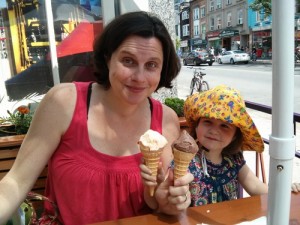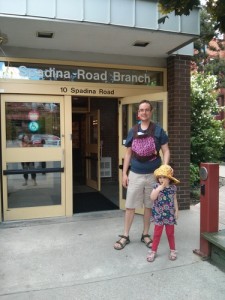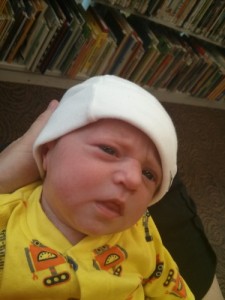September 9, 2024
My Stacky Authors

This weekend, Kate Atkinson joined an esteemed group of writers when her latest, Death at the Sign of the Rook (review to come! RAVE!), found its place in my personal library, and I determined that it was time for Atkinson to get stacky, which is what happens to authors who I like too much. And I actually kind of hate it, that I don’t get the pleasure of seeing books by my favourite authors with their colourful spines all in a row, but space is at a premium and I have to make it work (although my husband did recently suggest replacing one of our bookshelves with a taller one! SWOON!), but the only way I can accommodate the necessity of having 13 books by Atkinson on my shelf (does not even include the two of her earlier novels that I didn’t love and got rid of, which rankled the completest in me, but what can you do) is by stacking a bunch of them into a pile.
Which frees up so much space!! Room to breathe!!! Room for more books!! To be one of my stacky authors, really, is one of the largest literary compliments that I could pay you. You’d be in the company of Kate Atkinson, Joan Didion, Margaret Drabble, Jane Gardham, Penelope Lively, Hilary Mantel, Sue Miller (SO MANY L and M AUTHORS!), and Iona Whishaw.
Carol Shields is on the list now (there is more room among the Ss), for the next time shelf space gets tight.
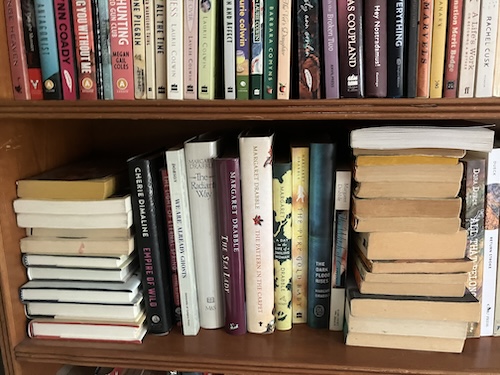
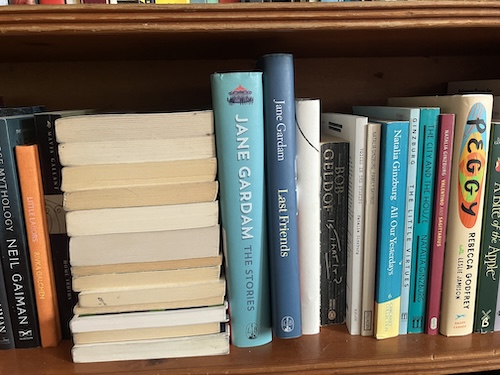
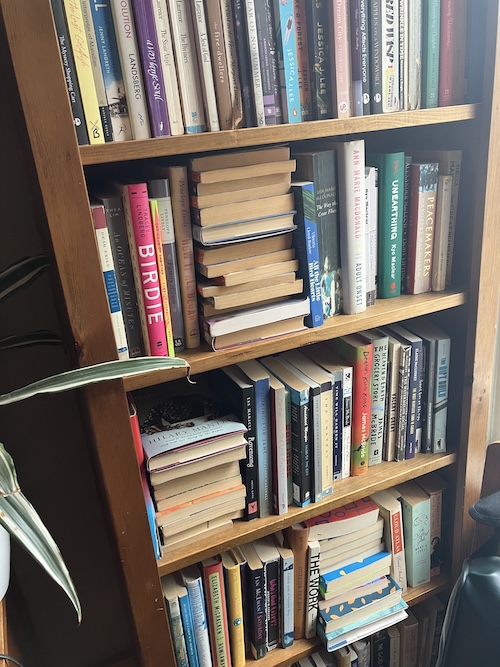
April 29, 2024
On Being Chosen
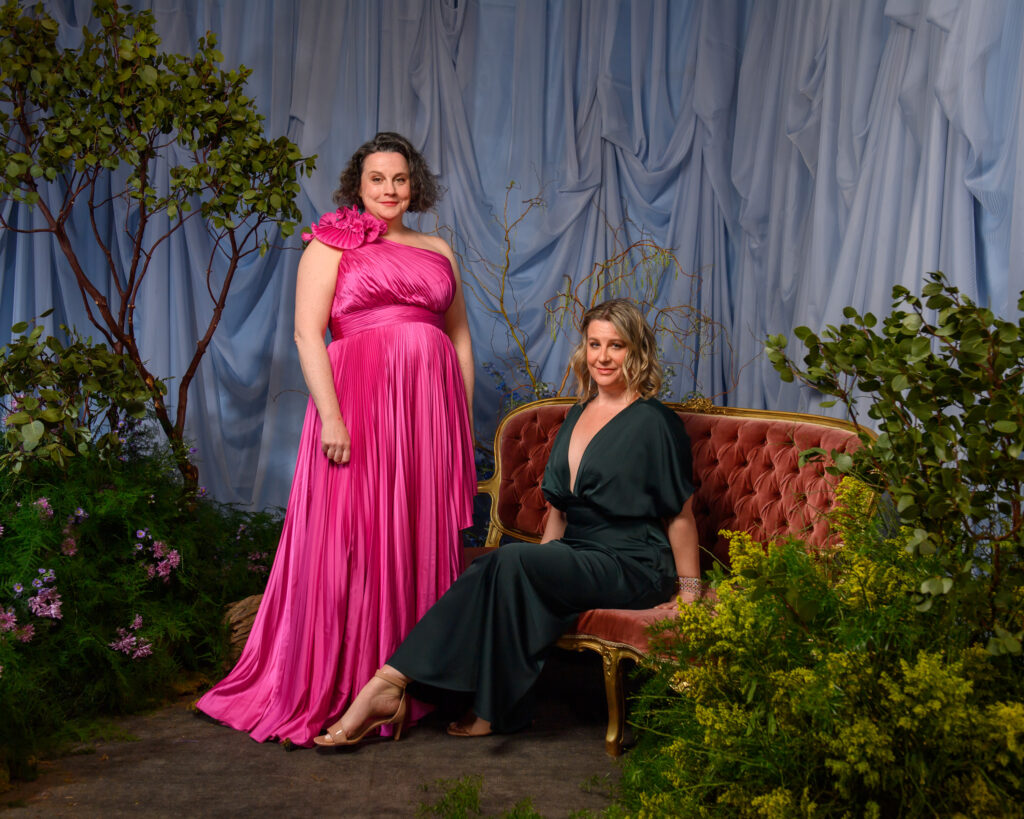
I’ve had a very fun and action-packed couple of weeks literary-wise that continues with tomorrow’s trip to Waterloo to interview Iona Whishaw about her latest Lane Winslow book. And a highlight was Thursday’s Biblio Bash at the Toronto Reference Library, a gala event at which I was invited to be a guest author. I’d attended once before in 2017 when my first novel came out, and the whole experience was intense, awesome, very overwhelming—plus I got my makeup done at the drug store and told them the look I was going for was “very dramatic” and ended up resembling a drag queen, and I’m still traumatized, no offence to drag queens. This time I had the benefit of hindsight and hired someone excellent to do my makeup, plus I’m about 300 years older than I used to be (pandemic effect) which meant I behaved with aplomb, looked quite fantastic, and drank so little that I woke up in the morning without a hangover, but still had lots of fun. It was a very good night and the Toronto Public Library Foundation raised more than a million dollars.
But I was cognizant through the entire process too that a big part of the experience (and one of its chief appeals, beyond the stunning portraits) was the feeling of being chosen. An exclusive event, an opportunity to mingle with the fancy people and wear a floor length gown. And I’ve been reflecting on this a lot, how much of the reality of publishing is often about the experiences of being chosen, or otherwise. Finishing your book, signing with an agent, getting a book deal, getting an impressive book deal, a book deal with a big press, becoming a bestseller, sustaining bestsellerdom, continuing that success with your next book, winning prizes, getting reviewed in all the best places, being “picked” by Oprah, Heather, Reese or Jenna, and on and on and on. And even when you get chosen on one level, there are all kinds of tiers and ways to still feel like you’ve been chosen (or that you’re falling short) and it’s all so urgent and arbitrary and so little of it (as with most things) is actually within any of our own control. Who gets to matter, to be important, and the pressure—even if you happen to be one of the ones—of staying on top, remaining relevant.
And all of it—it’s excruciating. I spent most of last fall feeling like such a failure, my self-worth so undermined by my latest novel’s failure to launch in the way I had envisioned—and thinking into the future, in which I might no longer be able to publish books at all, to be once again un-chosen by a publisher, and on one level, the stakes are negligible here, life goes on, but on the other, this is my career, and the thought of failure is just devastating once one has built their entire sense of self around the identity of not just being a writer, but one of those rarest of cases—a successful one.
There is a line from the Dar Williams song, “As Cool as I Am“, that I think (ugh!) I’m going to continue to be reminded of for the rest of my life: “And then I go outside to join the others; I am the others.” (You can even get a t-shirt!). So much of my own yearning to be chosen, to be validated, is to be offered proof that I am special and have worth. And of course I am special and have worth, by virtue of my existence as a human being, just like you do, but how to deal with that desire for distinction, for proof that I am not merely one of the others—it’s something else I’m figuring out at the age of almost-45, along with how to look good at a gala.
To accept that I am the others is realize that my sense of value and self-worth is intrinsic, rather than extrinsic, and that often nobody else is going to be see it but me, which means that I really have to know it, or no one will.
To quote another line from “As Cool as I Am”: “Oh, and that’s not easy.”
It’s really not, it’s so much easier to be seen by others than to see our ourselves as we really are, warts and all, and not even just accept it, but hold that reality as something worthy and sacred. It’s so much easier to share a photo of myself looking stunning at an exclusive shindig and have hundreds of people LIKE it than to sit with myself and know that this is all I’ll ever be.
But I’m working on it, little by little, building up a solid core, something unimpeachable.
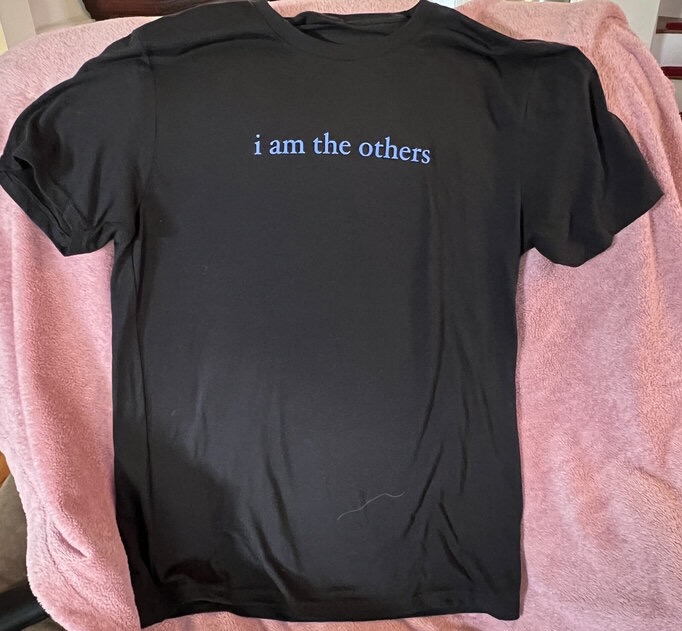
November 14, 2022
Palmerston
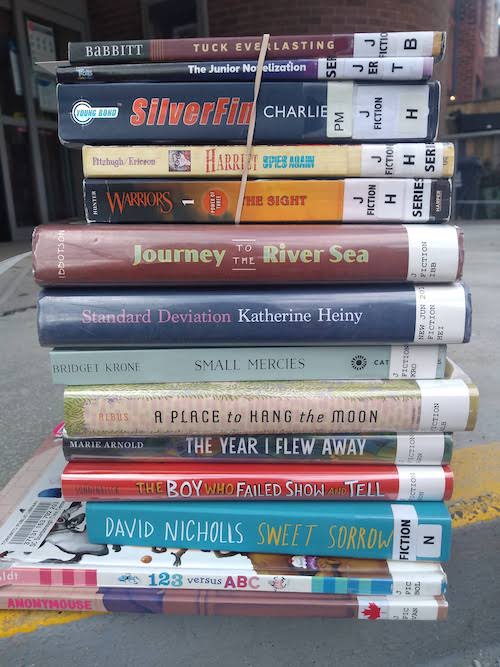
On Saturday we didn’t have a lot going on (a treat in itself), but I had to buy some berries (in preparation for guests on Sunday for whom we would be making breakfast, a friend and her beautiful family who we haven’t seen since 2019!) so we all walked over to Gold Leaf Market at Palmerston and Bloor (which is always the first place in the neighbourhood to get fresh rhubarb in the spring), and we decided to also stop by at the library. All these parenthesis, I hope you’ll understand, underlining the resonance of what I’m talking about, these local streets we’ve been circling through these difficult years as we’ve walked our way toward better times. No trip down the street is ever a straight line.
There are places we walked in the Covid times where we can’t bear to walk anymore—the small patch of woods at the university, the grubby little ravine just south of St. Clair and the ravine proper, any back alleyway and don’t even care about the garage door murals, nope. We walked those walks to save our insanity, and only managed it, JUST, or maybe we really didn’t, which is why we refuse to do it now. Nobody in our family can stand ice skating anymore, not that we really liked it very much in the first place.
Palmerston Library, however, is very different. A Covid destination for sure—our home branch was closed for a very long time beginning in 2020 and when the library reopened for circulation that summer, our holds were routed to Palmerston, which was the next closest—but it represented something different than walking in sad circles and feeling hopeless. I remember going to pick up a stack of books we’d requested and getting rhubarb on the way that spring and thinking what a miracle were both these things, how we were truly lucky.
“Remember when we had to put our cards on a tray?” I asked Stuart, and there was fondness to these memories, instead of despair. When the library opened again, we’d go pick up our books at the front door where plastic barriers were set up, and we’d hand over our library cards on a plastic tray that was slid back to us at the end, all of it slightly illicit, like a speakeasy, except books instead of booze. There were some weeks where going to pick up our library holds was the only item on our agenda, and so it was a big deal, and the librarians inside found even more ways to bring the books to us—there were grab bags geared to different age groups and genres, and also new releases in the window, each one numbered, so you could request the numbers you wanted, and somehow I ended up getting my hands on all kinds of new releases, like Beach Read, by Emily Henry, and The Girls Are All So Nice Here, by Laurie Flynn, and Sweet Sorrow, by David Nicholls, which I only chose because I liked the cover but I really really liked it.
I love to think about all this, about the treat of these wonderful novels in such a difficult time, about how much it meant to have a destination and not be aimless, and also about adaptation and ingenuity and the amazing ways that library staff found ways to make things work. (Remember when all circulating materials had to quarantine for a week before going out again, which meant it took SO LONG to get a book in demand, and also how we eventually determined that Covid was not being spread by library books, which was wonderful news?) I love to think about all this because it’s a story of trying things, daring to be different, of how much libraries and books meant to our communities, of being brave and taking chances, and how some of those chances work out exponentially (by which I mean that I am probably FAR from one of the only people you’re going to meet who think the library helped save her life).
Eventually, we could go inside again. I recall that we weren’t permitted to browse, but could pick up our own holds, and that computer terminals were available for those who needed them. I remember the first time I walked into a library again after so so long, and how I could have cried, and maybe I even did, because I was moved a lot in those days. And then when we could go back again and select our own books from the shelves, a little further down the line, and masks were required, though there would often be someone who didn’t have one (usually a person who was having other kinds of trouble), and we learned to be okay with that, which wasn’t easy, but it became easier, an essential lesson in sharing space with other people and how we can’t always (ever?) be in control of what other people do.
Our home branch opened again, and what a thing, and I can’t even remember when that happened, because it was just so ordinary, to stop in and pick up our books on the walk home from school, the kind of luxury I’d never thought twice about before, but it felt so wonderful after so long, and of course, things were not so straightforward. There was a while when our branch closed, and we were back to Palmerston, two steps back—albeit without the book quarantine and speakeasy card slide, so this was progress. But not every setback is a total disaster (something I often have to remind myself about after what we’ve all been through), and our branch reopened, and it had been such a long time since I’d been to Palmerston Library until this weekend.
And—unlike so many other things—it felt good to remember.
February 1, 2021
Virtual Author Talk
Last week I had the pleasure of two library events, and the live Toronto Library one was such a success, with so many of my favourite internet people tuning in. The next day we recorded my author visit to the Cobourg Public Library and it was also great, because not only was interviewer Ashley so fantastic, but she’d attended the TPL event the night before and was able to steer this one in a very different and fascinating direction. I had a lot of fun, there is so much energy and some real insight in the conversation, and I am delighted to be able to share it with you. Worth checking out, for sure.
April 30, 2017
A Remarkable Week for Mitzi and Me

As excellent weeks in the life of Mitzi Bytes go, I don’t know if any other will top this one. On Monday, I had the great pleasure of listening to my interview with Shelagh Rogers on The Next Chapter. On Tuesday, in preparation for the 1000 Islands Writers Festival (next weekend!!), I published a post on Mitzi Bytes and ambivalence on the festival blog. On Wednesday, I drove to Waterloo to partake in the Appetite for Reading Book Club event, which was so much fun, totally delicious, and dear friends were there, part of a room packed with avid readers—you can see some of their smiling faces above.

Thursday evening was the thoroughly bonkers and wholly enjoyable Toronto Library Bibliobash, which took place at the Toronto Reference Library, which is one of my favourite places on earth. It was hilarious fun and also a privilege to be able to support the library in such a wonderful way. It was very exciting to see Mitzi Bytes in such a setting…
And the next day I would discover it somewhere just as lovely—in Shawna Lemay’s beautiful response to the book at her blog, Transactions With Beauty.

Saturday was the third Authors for Indies day and I had the pleasure of a road trip with CanLit superstars Kate Hilton, Jennifer Robson, and Karma Brown, who were so much fun and (unsurprisingly) delightfully bookish. We went to Curiosity House Books in Creemore and Forsters Book Garden in Bolton, which was so wonderful because there is nothing I ever love more than a destination bookshop. It was terrific to meet the booksellers and the readers…and of course I bought a few books on my own. There was much raucousness and the snacks were great…
…and I arrived back home in time to listen to the rebroadcast of The Next Chapter with my family! (Happy to see Mitzi Bytes included on “15 books you heard about on CBC Radio this week”!).
One more thing—the new issue of The Hamilton Review of Books is up and it’s really great. And it also includes my review of Marianne Apostolides’ memoir, Deep Salt Water, which was such a joy to puzzle out and write about. I’m very pleased to be included in this issue. And I’m closing out here with a photo of Marissa Stapley and I from my Toronto Library Eh List Event on April 13. Marissa was wonderful and it was such a good night—one of many I’ve been experiencing lately.

July 7, 2016
Head in the Stars

Today UofT Magazine tweeted about scientists who inspire us, which reminded me to finally write this post which has been on my mind for awhile. About a month ago, my daughters got Stargazer Lottie (who was inspired by a space-obsessed six-year-old girl AND has been “the first doll in space”), which came with a “Notable Women in Astronomy” poster. But none of the notable women were Canadian, and it occurred to me that I knew of a very notable Canadian woman in astronomy, who was Dr. Helen Sawyer Hogg. Whose work I only knew, granted, because she’d had a page in my Grade 8 science textbook and my friend and I used to make fun of her name. Which is ridiculously stupid, but the point is that I never forgot her name, and googled her years later and discovered her story was fascinating. (Do textbook writers know the indirect routes that knowledge might take, I wonder? They would probably be surprised.)
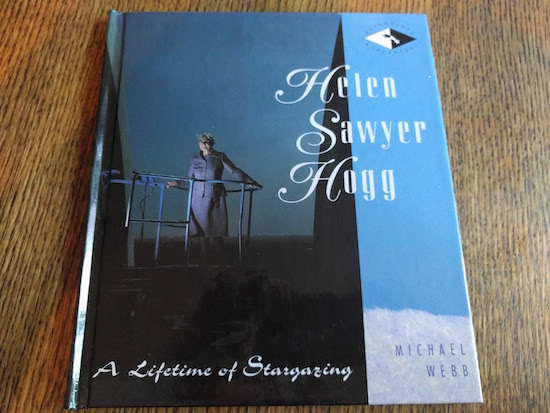
Dr. Helen Sawyer Hogg received her doctorate degree in astronomy in 1931, which is remarkable in itself. Her husband was also an astronomer and the two of them would work together until his death in 1951. Although Hogg’s work was not as valued as she was somebody’s wife, and she was often expected to do it without pay. Her first child was born in 1932 and Hogg kept the baby at work beside her in a basket while she studied star clusters at the Dominion Astrophysical Observatory in Victoria, BC. , where her husband was employed as a research assistant. Later that year she received a grant which was exactly enough to pay for a babysitter, and I am fascinated by the idea of how liberating that must have been—and also what it must be to be consumed by cosmic things and have a baby in a basket at once. How does a person reconcile such a vast difference of scale?
Her story would never cease to be cool. After her husband’s death, she took over many of his classes at the University of Toronto, where the family had moved in the mid-1930s. She also assumed ownership of his astronomy column for the Toronto Star, which she wrote for decades (and which was collected into a bestselling book called The Stars Are for Everyone).
There is no full biography of Dr. Hogg. Editions of a science biography for children was published by Michael Webb in the 1980s and 1990s, and while it’s pretty informative, I’m hungry for so much more depth. And so it seems I am going to have to do some of my own digging. Helen Sawyer Hogg’s archives are at the Thomas Fisher Library at UofT, and I think I’m going to have to make some plans to start going through them. In search of what, I am not sure. A creative project? A biographical article? But there is something here, I am sure of it. I look forward to reporting back on just what I might happen to find.
May 29, 2016
Alone in Montreal
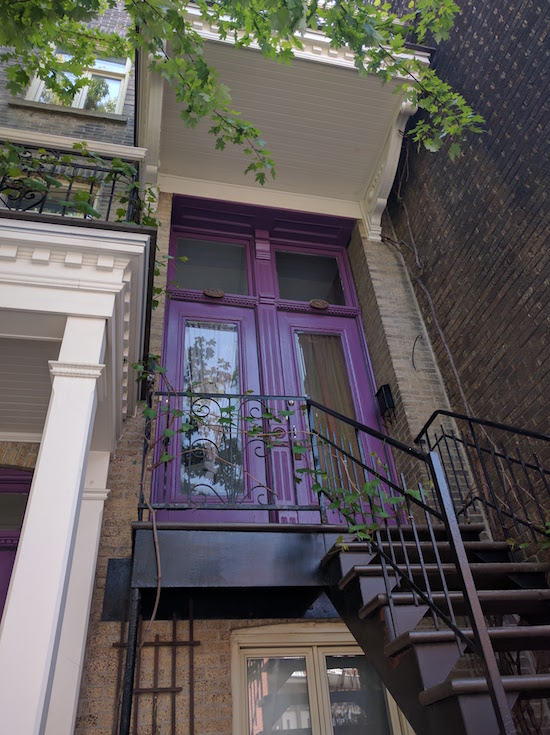
I’m not alone very often, and when I am, I am never lost or aimless. I say this not smugly, but as a mild lamentation. I don’t know that I’d like being alone, lost and aimless to be a pastime, but sometimes such things can lead a person places. This is what I teach in my blogging course, that a blogger needs space to roam, room to wander. And on Friday, I had some of that for myself, as I flew to Montreal to talk about blogging with the Association of English Language Publishers of Quebec. If you know me, you know I rarely leave my couch, so this was a pretty novel opportunity. I flew out from the Island Airport on Friday morning, the whole experience infused with goodness from the get-go—tea, ample leg-room and a good book. A whole hour and a bit in which to read.
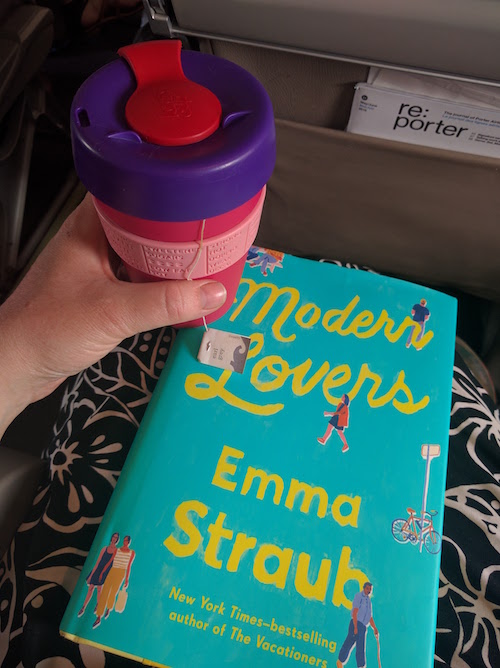
I had a few hours to kill before my event, so I made a plan to explore the Mile End neighbourhood and then make my way through the city to Westmount, where the AELAQ event was being held. My taxi from the airport dropped me off at Librairie Drawn and Quarterly, which immediately landed a space on my Best Bookshops I Have Ever Been To list. A world-famous publisher of amazing graphic novels and comics, they sell their own books, as well as other such books from other publishers, and then kids books, poetry, fiction, cookbooks etc etc making them a perfect general-interest/speciality hybrid. I walked in there and contemplated never leaving.
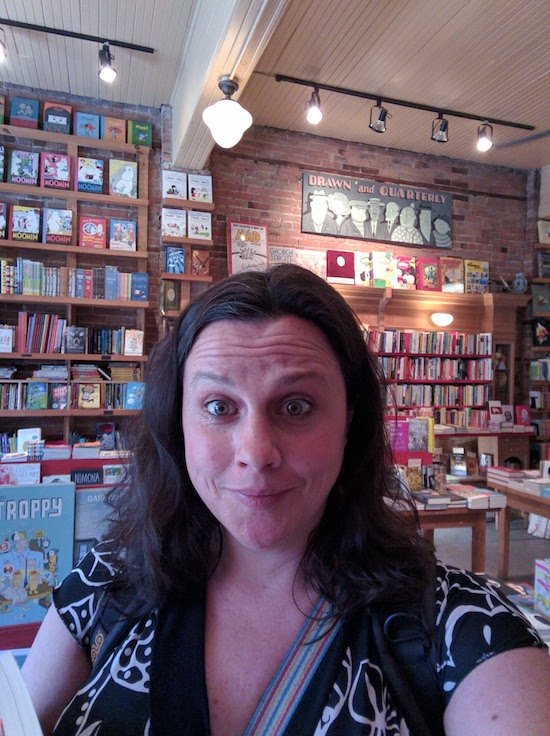
I ended up choosing Rivka Galchen’s Little Labors, which is SO GOOD and I read yesterday. I thought maybe I was through with moms making sense of the new baby books, but no. Looking forward to writing about this one more this week. I also got Photobooth: A Biography, by Meags Fitzgerald, and it’s brilliant. The rest of the books were for my family, and I think I chose very well.
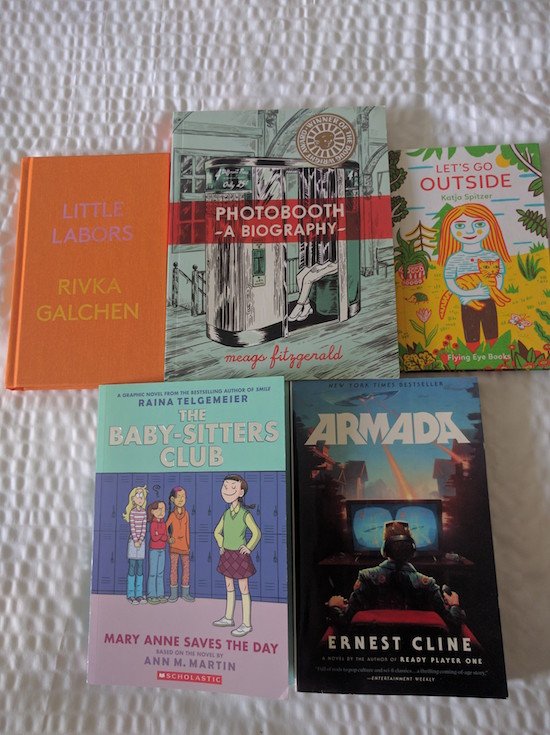
So of course this meant I had a pile of books now to add to all the stuff I had to carry, and although I have never, ever complained about carrying books (the most pleasurable burden I’ve ever had the privilege to experience), my load in general was kind of heavy. It was also 38 degrees outside (no lie: factoring humidity), but no matter, I was on my way. I felt more like Mary Tyler Moore than I usually feel ever, if she’d been making it after all in French Canada whilst carrying a stack of books. I hit up a boulangerie, and got a croissant, and then followed it up with an ice cream cone at Kem CoBa, double scoop because you only live once. And it was so hot that my ice cream was melting faster than I could eat it, and I do appreciate that Montreal was so kind to me in spite of the melted diary stains all over my bag. After that, I added a dozen bagels from Fairmount Bagel to my load, and then set off down Rue Saint-Urban toward my final destination.

It seemed ridiculously hot, though I think the heat (and the books. and the bagels) were the problem, plus I had to wear a giant shirt because I continue to be allergic to the SUN. I walked through Jewish neighbourhoods, a Portuguese neighbourhood, skirted the park and the mountain, and then arrived downtown where I turned and walked along Rue Sherbrooke, though the McGill Campus and past museums and galleries and there was so much to see..and I was so very hot and did not seem to be arriving at my hotel ever. So I had to stop and steal wi-fi from the Ritz Carlton (whose signal is very strong, stretches all the way across the street) to figure out where I was going. Luckily the right way. I got there eventually, to my hotel with enough time to cool down and change my clothes and iron my dress and be ready for my presentation, which was not far away at the Atwater Library.
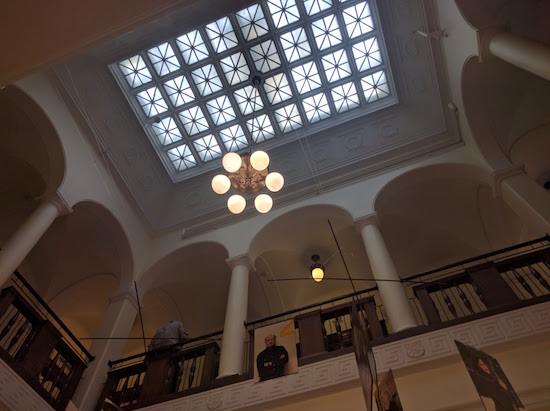
As would be apt for a presentation about how blogging in 2016 is small and focussed, the group that arrived for my presentation was much the same—and they were WONDERFUL. I had such a wonderful time giving my talk, and the group was so receptive, and I was pleased to meet some people again, meet others for the first time, and in particular people whom I’d grown to like already in engaging with them online. It was a terrific experience, and such a privilege to be there. And I was so appreciative to everybody for making me feel so welcome. (And for coming, even though it was by then the middle of a rainstorm and thunder was rumbling outside).
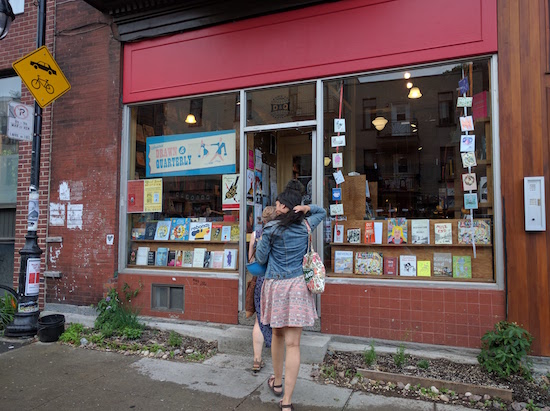
Afterwards, a few of us piled into a taxi and headed back up to Drawn and Quarterly for the Biblioasis launch of books by Alice Petersen and Catherine Laroux. It was a pleasure to be back there and also to have it all set up for an event, and to meet other local writers and readers and get a feel for the Montreal English literary scene. I was so happy to hang out with Saleema Nawaz, who contributed to The M Word and who i’ve long admired, but had really only met fleetingly, and also Elise Moser (who has a new nonfiction children’s title coming out in the fall about “the pioneer of plastics recycling”) and Alice Zorn (whose latest novel, Five Roses, I am so excited to have ahead of me). The readings were great, and then afterwards, we went out for dinner and drank bourbon lemonade and ate fried chicken and nothing annoying or not wonderful had happened to me all day (nearly collapsing from heat stroke notwithstanding). It was nice to be alone in Montreal, particularly in those moments when I actually wasn’t.

Spending the night in a hotel room BY MYSELF (without even sand in the bed. I like holidays, but the bane of my existence is sand in the bed, but there were none in this one) was a ridiculous indulgence, so surrounded was I by good pillows, clean sheets, a comfortable mattress, and many many books. Once I stopped reading I slept soundly, and then spent the morning enjoying a few good hours of quiet and aloneness before it was time to fly back home again.
October 17, 2015
Happy Birthday, Lillian H. Smith, and The Story Project
 Today was the Lillian H. Smith Library’s 20th birthday party, and we rushed down to College Street after Iris’s nap to catch the end of it. The library has been a special part of our family for the last five years—I wrote about it first in 2011 as part of my “Wild Libraries I Have Known” series, and it also came up in my post about Joan Bodger and Mad Men. It’s truly an extraordinary place—we were there for the Crayon Creators event just a few weeks ago, and last summer completely by mistake we stumbled upon an amazing African drumming workshop because that’s the kind of thing that just happens at the Lillian H. Smith Library.
Today was the Lillian H. Smith Library’s 20th birthday party, and we rushed down to College Street after Iris’s nap to catch the end of it. The library has been a special part of our family for the last five years—I wrote about it first in 2011 as part of my “Wild Libraries I Have Known” series, and it also came up in my post about Joan Bodger and Mad Men. It’s truly an extraordinary place—we were there for the Crayon Creators event just a few weeks ago, and last summer completely by mistake we stumbled upon an amazing African drumming workshop because that’s the kind of thing that just happens at the Lillian H. Smith Library.
So we wanted to share in the celebration, and yes, we were told there would be cake. And there was! Plus spring rolls and cups of tea (ala Alice!—“Illustrating Alice” is the exhibit currently on at the Osborne Collection of Early Children’s Books). We were glad to see our beloved Joanne, children’s librarian extraordinaire. There were crafts and face-painting. And the gorgeous bookish birthday table…
Even better? Today was also the launch of the Lillian H. Smith Library Story Project, imagined and brought to reality by the amazing Christina Wong, a library page. Over the summer she collected stories from people with connections to the library, and put them all together on the site. I was happy to share stories about how the library has been so important to my experiences as a mother and our family life in the city: you can listen to it here. (Interestingly, it’s the first time that listening to my voice has not made me want to die… I’m really pleased with how our interview turned out.)
So far I’ve also listened to Andrew Larsen on the role the library has played in his development as a children’s author, and Ken Setterington on the story of Joan Bodger and her husband’s ashes. Looking forward to listening to the rest.
And I’m so happy to have been a part of this project, which celebrates one of my favourite places in the world.
May 15, 2013
Basements and Attics, Closets and Cyberspace: Explorations in Canadian Women’s Archives by Morra & Schagerl
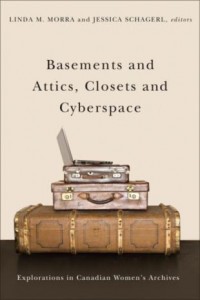 I am one of those readers who has bought into the romanticism of libraries and archives, Barbara Pym heroines and Maud Bailey in Possession. In 2001, I helped to unpack the Woolf Collection at the Pratt Library in its new sub-basement home, and it was one of the most remarkable things I’ve ever done. And even when it’s not romantic, archives are fascinating; one of my favourite books of recent years was Outside the Box by Maria Meindl about legacy of her grandmother’s archive, and unexpected questions: what do you do with a pile of papers covered on dust and cat hair, a colostomy bag stuck to the back? A question that probably wouldn’t faze most archival librarians, as Meindl discovers, and Susan McMaster too in her essay “Rat in the Box: Thoughts on Archiving My Stuff” from Basements and Attics, Closets and Cyberspace: Exploration in Canadian Women’s Archives (Linda M. Morra and Jessica Schagerl, eds). Her essay begins with a literary archivist asking for details, “Mouse turds or rat turds? A few mouse turds are nothing, they can be brushed off…”
I am one of those readers who has bought into the romanticism of libraries and archives, Barbara Pym heroines and Maud Bailey in Possession. In 2001, I helped to unpack the Woolf Collection at the Pratt Library in its new sub-basement home, and it was one of the most remarkable things I’ve ever done. And even when it’s not romantic, archives are fascinating; one of my favourite books of recent years was Outside the Box by Maria Meindl about legacy of her grandmother’s archive, and unexpected questions: what do you do with a pile of papers covered on dust and cat hair, a colostomy bag stuck to the back? A question that probably wouldn’t faze most archival librarians, as Meindl discovers, and Susan McMaster too in her essay “Rat in the Box: Thoughts on Archiving My Stuff” from Basements and Attics, Closets and Cyberspace: Exploration in Canadian Women’s Archives (Linda M. Morra and Jessica Schagerl, eds). Her essay begins with a literary archivist asking for details, “Mouse turds or rat turds? A few mouse turds are nothing, they can be brushed off…”
The connections between the essays in Basements and Attics, Closets and Cyberspace are broad and strange, as befitting a book of “explorations”. Why “Women’s Archives” in particular? Because it’s a whole different game that requires in some cases a redefinition of what archives are. One can’t go looking in ordinary places for women’s history, because for so long there was no such thing, and different ethical questions are raised about public and personal stories. But what does it mean for the archive to change the definition of archive? What is expanded and what is undermined? The book is a fascinating exploration indeed, and while it’s published by an academic press and makes a fair number of references to Derrida, much of it was accessible to the likes of me, and was a really enjoyable read.
In “Of Mini-Ships and Archives”, Daphne Marlatt writes of language itself as an archive, and asks, “Does writing… inherently contain the possibility of going public?” based on her experiences in archives using personal stories to provide context for larger issues. Cecily Devereau posits eBay as an archive, discussing its advantages and limitations over tradition archives in the quest for “Indian Maiden” lore. “Faster Than a Speeding Thought” by Karis Schearer and Jessica Schagerl was of particular interest to me, examining poet Sina Queyras’ blog Lemon Hound, the blog as archive and ethical implications of this (there is no permanence; who do comments belong to?; can there be such a thing as a paperless archive?) and poses interesting questions about blogs in general: “Although, on the one hand, controlling the means of publication can be a powerful tool for shaping the literary field, on the other hand, it does have its own implications for women’s labour.” In “Archiving the Repertoire of Feminist Cabaret in Canada”, T.L. Cowan attempts to use anecdotes to recreate an event whose ephemera has been entirely lost, and discusses what kind of archive emerges from this exercise. Penn Kemp writes about archives from the point of view of the archivee, as does Sally Clark who discusses her own discomfort with archiving and the question it requires of her: “What are you worth?”
In “Keeping the Archive Door Open: Writing About Florence Carlyle”, Susan Butlin presents some of the unique challenges of researching Canadian women’s history, and the role of her own prejudices in the process (as she discovers the more commercial ventures of the artist Carlyle). Ruth Panofsky and Michael Moir’s “Halted by the Archive: The Impact of Excessive Archival Restrictions on Scholars” tells of Panofsky’s experiences with Adele Wiseman’s archives when Wiseman’s daughter suddenly made her mother’s archives inaccessible to scholars. The limits of traditional archives are further explored in Karina Vernon’s “Invisibility Exhibit: The Limits of Library and Archives Canada’s “Multicultural Mandate”. Katja Thieme uses letters to the Woman’s Page of Grain Grower’s Guide to show how the page function as an archive of rhetoric which underlines our understanding of the Canadian suffrage movement. Vanessa Brown and Benjamin Lefebvre discuss the archive of LM Montgomery and its role in their own work, as well as its inherent gaps and mysteries. Kathleen Venema uses an archive of her own–a collection of letters exchanged between her and her mother decades ago–to create a new archive and explore the limits of her mother’s memory as she becomes more and more afflicted with Alzheimer’s. In “Locking Up Letters”, Julia Creet questions what is she to do with her mother’s letters about her experiences during the Holocaust when the letters are of vast historical import but also recount experiences that her mother spent the rest of her life trying to flee from and hide.
Basements and Attics, Closets and Cyberspace is not a tidy book, but what exploration in an archive (or any one worth exploring) ever would be? Rather than putting away things in boxes, this book throws the boxes open wide, inviting more questions than answers, and demanding a broader point of view.


